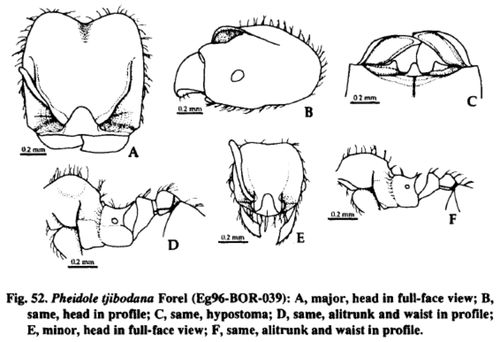Pheidole tjibodana
| Pheidole tjibodana | |
|---|---|

| |
| Scientific classification | |
| Kingdom: | Animalia |
| Phylum: | Arthropoda |
| Class: | Insecta |
| Order: | Hymenoptera |
| Family: | Formicidae |
| Subfamily: | Myrmicinae |
| Tribe: | Attini |
| Genus: | Pheidole |
| Species: | P. tjibodana |
| Binomial name | |
| Pheidole tjibodana Forel, 1905 | |
Eguchi (2008) - This species is wide spread through the Indo-Chinese and Indo-Malayan subregions, and inhabits forest from lowland to hilly areas. Bornean populations usually nest in litter, but Vietnamese populations usually nest in rotting twigs and small wood fragments. Small seeds are sometimes stored inside the nest [Eg96-BOR-031, Eg04-VN-215]. The number of adults per colony is: 8 majors, 71 minors, 1 dealate queen & 3 alate queens [Eg04-VN-204]; 5 majors, 52 minors & 1 dealate queen (with queen pupae) [Eg04-VN-207]; 24 majors, 259 minors, 1 dealate queen & 31 alate queens [Eg04-VN-215]. Heterick & Kitching (2022) collected this species in leaf litter within a lowland dipterocarp forest in Brunei.
Identification
Eguchi (2008) - Based on his examination of the type material Eguchi (2001a) distinguished Pheidole tjibodana from Pheidole nodgii based on the following differences: posterior part of frons of the major higher in P. tjibodana than in P. nodgii; posterior slope of promesonotal dome of the minor steeper in P. tjibodana than in P. nodgii. Intermediate conditions in each of the two “diagnostic characters” were, however, observed in the present examination of nontype material. On the other hand, postpetiole of the minor of P. nodgii were always highly raised and somewhat globular in lateral view. I at present treat them as different species, although only two colonies (FI96-253 & FI97-551 from Bogor, W. Java) referable to P. nodgii have been found.
This species is well characterized among Indo-Chinese species by the combination of the following features: in the major frontal carina well developed horizontally, partly overhanging antennal scrobe; in the major median process well developed but submedian processes absent; in the minor dorsum of head and mesosoma punctured or reticulate with enclosures punctured weakly or dimly; in the major and minor promesonotal dome in lateral view at most with a low or inconspicuous mound on its posterior slope.
Keys including this Species
- Key to the Pheidole of North Vietnam
- Key to Pheidole majors and minors of Borneo
- Key to Pheidole majors of Borneo
- Key to Pheidole minors of Borneo
Distribution
Known from the Indo-Chinese and Indo-Malayan subregions.
Latitudinal Distribution Pattern
Latitudinal Range: 11.91666667° to 3.7425°.
| North Temperate |
North Subtropical |
Tropical | South Subtropical |
South Temperate |
- Source: AntMaps
Distribution based on Regional Taxon Lists
Indo-Australian Region: Borneo, Brunei Darussalam, Indonesia (type locality), Malaysia, Philippines, Singapore.
Oriental Region: Cambodia, Thailand, Vietnam.
Palaearctic Region: China.
Distribution based on AntMaps
Distribution based on AntWeb specimens
Check data from AntWeb
Countries Occupied
| Number of countries occupied by this species based on AntWiki Regional Taxon Lists. In general, fewer countries occupied indicates a narrower range, while more countries indicates a more widespread species. |

|
Estimated Abundance
| Relative abundance based on number of AntMaps records per species (this species within the purple bar). Fewer records (to the left) indicates a less abundant/encountered species while more records (to the right) indicates more abundant/encountered species. |

|
Biology
Castes
Worker
Minor
Images from AntWeb
   
| |
| Worker. Specimen code casent0281726. Photographer Estella Ortega, uploaded by California Academy of Sciences. | Owned by NHMUK, London, UK. |
   
| |
| Syntype of Pheidole nodgii tjibodana. Worker. Specimen code casent0904241. Photographer Will Ericson, uploaded by California Academy of Sciences. | Owned by MSNG, Genoa, Italy. |
   
| |
| Paralectotype of Pheidole tjibodana. Worker. Specimen code casent0907984. Photographer Will Ericson, uploaded by California Academy of Sciences. | Owned by MHNG, Geneva, Switzerland. |
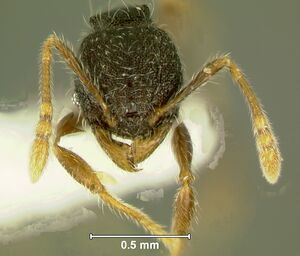   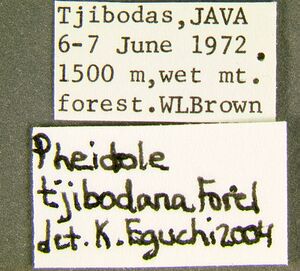
| |
| . | |
Major
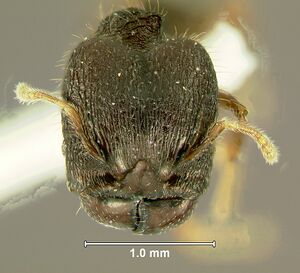 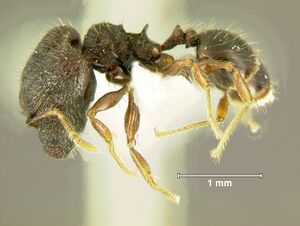 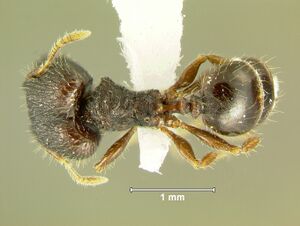         
| |
| . | |
Nomenclature
The following information is derived from Barry Bolton's Online Catalogue of the Ants of the World.
- tjibodana. Pheidole nodgii var. tjibodana Forel, 1905c: 16 (s.w.q.) INDONESIA (Java). Raised to species: Eguchi, 2001a: 29. See also: Eguchi, 2001b: 123; Eguchi, 2008: 93.
Unless otherwise noted the text for the remainder of this section is reported from the publication that includes the original description.
Description
Worker
Eguchi (2008) - Major (n=5). — HL 0.97–1.14 mm, HW 0.95–1.05 mm, CI 89–100, SL 0.49–0.53 mm, SI 48–52, FL 0.54–0.63 mm, FI 56–61. Minor (n=5). — HL 0.51–0.55 mm, HW 0.49–0.55 mm, CI 92–100, SL 0.42–0.47 mm, SI 84–96, FL 0.45–0.51 mm, FI 90–100.
Major — Head in lateral view not or hardly impressed on vertex, sometimes highly raised on the posterior part of frons; anterior part of frons longitudinally rugose; posterior part of frons, vertex and dorsal and dorso-lateral faces of vertexal lobe reticulate; frontal carina well developed horizontally, partly overhanging antennal scrobe; median longitudinal carina of clypeus absent, or sometimes present but very weak; hypostoma with a very large median process in addition to well-developed lateral processes; submedian processes nearly or completely absent; outer surface of mandible (excluding area around the base) smooth, with sparse and very short appressed hairs; antenna with a 3-segmented club; maximal diameter of eye longer or much longer than antennal segment X. Promesonotal dome in dorsal view reticulate, in lateral view at most with an inconspicuous or low mound/process on its posterior slope; humerus moderately produced laterad; the dome at the humeri as broad as or broader than at the bottom; propodeal spine usually well developed as a long horn. Petiole much longer than postpetiole (excluding helcium); postpetiole not massive. First gastral tergite smooth to shagreened largely, or weakly punctured anteriorly and shagreened posteriorly.
Minor — Dorsum of head well punctured and overlain by weak rugoso-reticulation, or well reticulate with enclosure weakly or dimly punctured; preoccipital carina inconspicuous or very weak dorsally; median part of clypeus rugoso-reticulate, or punctured and overlain by very weak rugoso-reticulation; median longitudinal carina absent, or present as rugula(e); antenna with a 3-segmented club; scape usually exceeding posterior margin of head by less than the length of antennal segment II, but sometimes not exceeding posterior margin; maximal diameter of eye almost as long as or a little longer than antennal segment X (but rarely a little shorther than antennal segment X). Dorsum of promesonotal dome well punctured and overlain by weak rugoso-reticulation, or well reticulate with enclosure weakly or dimly punctured; lateral face of promesonotal dome, mesopleuron, metapleuron and lateral face of propodeum well punctured; promesonotal dome in lateral view lacking a conspicuous mound on its posterior slope; humerus of the dome in dorso-oblique view produced weakly or forming a small tubercle; propodeal spine variable in size and shape. Petiole much longer than postpetiole (excluding helcium); postpetiole not massive.
Type Material
Pheidole nodgii var. tjibodana. Lectotype: major, “Tjibodas, Java K. Kraepelin leg. 25-28/ III/1904” [Cibodas, Java, Indonesia], Musee d'Histoire Naturelle Genève, examined; paralectotypes: 1 minor & 1 queen, same data as lectotype, MHNG, examined.
References
- Eguchi, K. 2001a. A revision of the Bornean species of the ant genus Pheidole (Insecta: Hymenoptera: Formicidae: Myrmicinae). Tropics Monograph Series. 2:1-154.
- Eguchi, K. 2001b. A taxonomic study on Asian Pheidole (Hymenoptera, Formicidae): new synonymy, rank changes, lectotype designations and redescriptions. Insecta Koreana. 18:1-35. (page 29, Raised to species)
- Eguchi, K. 2008. A revision of Northern Vietnamese species of the ant genus Pheidole (Insecta: Hymenoptera: Formicidae: Myrmicinae). Zootaxa 1902:1-118.
- Forel, A. 1905f. Ameisen aus Java. Gesammelt von Prof. Karl Kraepelin 1904. Mitteilungen aus dem Naturhistorischen Museum in Hamburg 22: 1-26. (page 16, soldier, worker, queen described)
- General, D.E.M. 2021. A preliminary checklist of the ants (Hymenoptera: Formicidae) of the Mt. Pantaron Range, Bukidnon Province, Mindanao Island, Philippines. Halteres, 12:4-14 (doi:10.5281/ZENODO.5371745).
- General, D.E.M., Buenavente, P.A.C., Rodriguez, L.J.V. 2020. A preliminary survey of nocturnal ants, with novel modifications for collecting nocturnal arboreal ants. Halteres 11: 1-12 (doi:10.5281/ZENODO.3707151).
- Heterick, B.E., Kitching, R.L. 2022. The ants (Hymenoptera: Formicidae) of a one-hectare plot of lowland dipterocarp forest. Entomologist’s Monthly Magazine 158(4), 261–272 (doi:10.31184/m00138908.1584.4153).
- Khachonpisitsak, S., Yamane, S., Sriwichai, P., Jaitrong, W. 2020. An updated checklist of the ants of Thailand (Hymenoptera, Formicidae). ZooKeys 998, 1–182 (doi:10.3897/zookeys.998.54902).
- Nooten, S.S., Lee, R.H., Guénard, B. 2021. Evaluating the conservation value of sacred forests for ant taxonomic, functional and phylogenetic diversity in highly degraded landscapes. Biological Conservation 261, 109286 (doi:10.1016/j.biocon.2021.109286).
- Wang, W.Y., Soh, E.J.Y., Yong, G.W.J., Wong, M.K.L., Benoit Guénard, Economo, E.P., Yamane, S. 2022. Remarkable diversity in a little red dot: a comprehensive checklist of known ant species in Singapore (Hymenoptera: Formicidae) with notes on ecology and taxonomy. Asian Myrmecology 15: e015006 (doi:10.20362/am.015006).
References based on Global Ant Biodiversity Informatics
- Chapman, J. W., and Capco, S. R. 1951. Check list of the ants (Hymenoptera: Formicidae) of Asia. Monogr. Inst. Sci. Technol. Manila 1: 1-327
- Eguchi K. 2001. A revision of the Bornean species of the ant genus Pheidole (Insecta: Hymenoptera: Formicidae: Myrmicinae). Tropics Monograph Series 2: 1-154.
- Eguchi K. 2001. A taxonomic study on Asian Pheidole (Hymenoptera, Formicidae): new synonymy, rank changes, lectotype designations and redescriptions. Insecta Koreana 18: 1-35.
- Eguchi K. 2008. A revision of Northern Vietnamese species of the ant genus Pheidole (Insecta: Hymenoptera: Formicidae: Myrmicinae). Zootaxa 1902: 1-118.
- Eguchi K.; Bui T. V.; Yamane S. 2011. Generic synopsis of the Formicidae of Vietnam (Insecta: Hymenoptera), part I Myrmicinae and Pseudomyrmecinae. Zootaxa 2878: 1-61.
- Fontanilla A. M., A. Nakamura, Z. Xu, M. Cao, R. L. Kitching, Y. Tang, and C. J. Burwell. 2019. Taxonomic and functional ant diversity along tropical, subtropical, and subalpine elevational transects in southwest China. Insects 10, 128; doi:10.3390/insects10050128
- Forel A. 1905. Ameisen aus Java. Gesammelt von Prof. Karl Kraepelin 1904. Mitt. Naturhist. Mus. Hambg. 22: 1-26.
- Guénard B., and R. R. Dunn. 2012. A checklist of the ants of China. Zootaxa 3558: 1-77.
- Jaitrong W.; Nabhitabhata, J. 2005. A list of known ant species of Thailand. The Thailand Natural History Museum Journal 1(1): 9-54.
- Kadoorie Farm and Botanic Garden, 2002. Report of Rapid Biodiversity Assessments at Nonggang National Nature Reserve, Southwest Guangxi, China, 19 to 27 May 1998. South China Forest Biodiversity Survey Report Series (Online Simplified Version): No. 10. KFBG, Hong Kong SAR, ii + 34p.
- Kishimoto-Yamata K., F. Hyodo, M. Matsuoka, Y. Hashimoto, M. Kon, T. Ochi, S. Yamane, R. Ishii, and T. Itioka. 2012. Effects of remnant primary forests on ant and dung beetle species diversity in a secondary forest in Sarawak, Malaysia. Journal of Insect Conservation DOI 10.1007/s10841-012-9544-6
- Pfeiffer M., D. Mezger, and J. Dyckmans. 2013. Trophic ecology of tropical leaf litter ants (Hymenoptera: Formicidae) - a stable isotope study in four types of Bornean rain forest. Myrmecological News 19: 31-41.
- Pfeiffer M.; Mezger, D.; Hosoishi, S.; Bakhtiar, E. Y.; Kohout, R. J. 2011. The Formicidae of Borneo (Insecta: Hymenoptera): a preliminary species list. Asian Myrmecology 4:9-58
- Woodcock P., D. P. Edwards, R. J. Newton, C. Vun Khen, S. H. Bottrell, and K. C. Hamer. 2013. Impacts of Intensive Logging on the Trophic Organisation of Ant Communities in a Biodiversity Hotspot. PLoS ONE 8(4): e60756. doi:10.1371/journal.pone.0060756
- Woodcock P., D. P. Edwards, T. M. Fayle, R. J. Newton, C. Vun Khen, S. H. Bottrell, and K. C. Hamer. 2011. The conservation value of South East Asia's highly degraded forests: evidence from leaf-litter ants. Phil. Trans. R. Soc. B. 366: 3256-3264.
- Zryanin V. A. 2011. An eco-faunistic review of ants (Hymenoptera: Formicidae). In: Structure and functions of soil communities of a monsoon tropical forest (Cat Tien National Park, southern Vietnam) / A.V. Tiunov (Editor). – M.: KMK Scientific Press. 2011. 277 р.101-124.


